Optimising organisational practices for digital success
Considering the challenges faced by numerous organisations in achieving their digital objectives and goals, we look beyond the technology to the people at the heart of driving measurable change. In this blog post, our Principal Systems Engineer, Kristian Jones dives into how improving organisational team structure can optimise business practices and deliver continuous and sustainable results.
How to improve organisational structure
Utilising Conway’s Law to Your Advantage
Conway’s law, often referenced in software development environments, holds valuable insights that extend beyond system design to various organisations and their team constructs. Understanding the correlation between organisational structure and solution development is essential for successful outcomes.
"Organizations which design systems are constrained to produce designs which are copies of the communication structures of these organisations"
In-depth, Conway suggests that solutions built in misalignment with organisational structures are prone to issues. For instance, consider whether your team members have appropriate access to perform critical tasks for project success, or are they relying on another team to carry out those tasks? An issue could arise if your team lacks access to crucial tasks necessary for project success. Let’s say you have three teams working on different project components. In this case, the integration of these individual components may be desired. However, alternatively, a solution to mitigate this issue would be to apply the “inverse Conway maneuver,” which involves reshaping teams to align with the desired architecture. Some organisations have even physically separated teams to achieve the required architecture.
Powerful teams are cohesive units, with individuals collaborating effectively to achieve desired outcomes. Teams typically progress through Bruce Tuckman’s five stages:
- Forming
- Storming
- Norming
- Performing
- Adjourning
Any changes to a team without due consideration of integration and alignment to common goals can lead to a decline in output. Optimising team output requires keeping teams in the performing stage for as long as possible.
Team size is also debated, with effective teams often consisting of 7-9 individuals*, allowing for efficient communication paths, Amazon identifies the ideal team size ‘small enough to be fed by two pizzas’! Typically larger teams increase the complexity of acting as a cohesive unit.
Exploring Four Fundamental Team Topologies

Image credit: Yoan-thirion
Matthew Skelton and Manuel Pais* outline four main types of teams within organisations:
- Stream-aligned teams: These teams are typically the primary workforce aligned with specific streams of work, such as product development.
- Enabling teams: Comprising specialists who provide support and assistance to stream-aligned teams.
- Complicated subsystem teams: These teams focus on developing and maintaining complex subsystems, relieving the cognitive load on stream-aligned teams. The work produced by these teams is often of higher quality compared to that of the stream-aligned teams themselves.
- Platform teams: These teams have gained popularity and specialise in developing internal tools and products that enhance the performance of stream-aligned teams.
Each team type typically interacts with other in different ways such as:
- Facilitation: Enabling teams typically facilitate other teams, usually involving working with other teams to help them solve a problem.
- X-As-A-Service: Platform teams typically provide services to teams ‘as a service’.and usually in the form of documentation instead of close collaboration. This allows platform teams to build a platform for many teams without being overburdened by the amount of communication paths with every team.
- Collaboration: Typically short-term intensive collaboration with another team. This is typically used by complicated subsystem teams and once the subsystem is matured then it’s typically just maintenance. Collaboration can be used by other team types for short-term goals, e.g. a platform team building a new platform and working closely with a single team for discovery of requirements. While collaboration can foster intensive short-term cooperation, it should be used sparingly due to increased cognitive load on teams.
Team APIs: Streamlining Communication
Many organisations overlook the significance of enabling efficient communication within and across teams, often relying on unwritten rules for collaboration. To mitigate this, the concept of Team APIs has emerged.
What is a Team API?
Team APIs refer to documented interfaces that teams establish, outlining how they should collaborate. Inspired by technical APIs, which facilitate computer communication, Team APIs contain crucial information about team composition, services provided, relevant SLAs, communication methods, and more. By implementing Team APIs, teams can minimise friction, clarify communication expectations, and enhance overall effectiveness.
Resource: provides an effective team API template
Accelerating Team Performance
Implementing changes however, should be approached with caution, especially if teams are already in the performing stage of development, the impact is likely a temporary reduction in performance.

The Lippitt/Knoster model is effective in highlighting the importance of aligning teams with a shared vision and provides a framework to recommend the following practical strategies to optimise team interactions and size;
- Aligning with a shared vision: Before implementing any changes, it is vital to ensure that all team members understand and embrace the vision. By fostering a sense of ownership and relevance, teams are more likely to drive success. The Lippitt/Knoster model focuses on managing complex changes by involving all stakeholders in the decision-making process.
- Optimising team interactions: Identify each team’s type and assess its interaction modes. For example, a platform team might benefit from adopting X-As-A-Service interaction mode. Tailor the interaction modes to suit the unique needs of each team. Furthermore, pay attention to team size. Ensure that each team is appropriately sized for maximum efficiency and productivity.
- Sustaining the performing stage: Implement changes in a manner that allows teams to remain in the performing stage as long as possible. Abrupt alterations can temporarily reduce performance and confuse team members. By carefully managing the transition, you can minimise disruption and increase the likelihood of success.
- Documenting Team APIs: Encourage teams to document their Team APIs (Application Programming Interface) with one another. This documentation should reflect the current state of collaboration and evolve over time as teams undergo changes. By establishing streamlined communication and clear expectations, teams can improve productivity and reduce conflicts.
However, do consider the impact of these changes on your organisation’s architecture;
Implications for Organisational Architecture:
- Addressing codebase sharing: Changing team structures may lead to architecture shifts. For instance, splitting a large team into two may result in shared codebases. However, this can cause friction if one team fails to meet its goals due to the other team’s mistakes. To resolve this, a re-architecture may be necessary, ensuring that teams have independent codebases that mirror their organisational structures.
- Empowering platform teams: To enhance internal platforms’ stability and quality, platform teams should have control over changes. Implement code reviews by the platform team and consider providing additional features to streamline workflow. For instance, stream-aligned teams could be allowed to create and maintain scheduled tasks within their respective boundaries.
As organisations strive to meet digital business goals, compromise becomes essential. By prioritising continuous and sustainable delivery, teams are empowered to excel where it matters the most. Establishing effective communication paths within teams and reducing inter-team communication can optimise efficiency and drive successful outcomes. With cautious implementation and a clear vision, organisations can navigate change while maintaining high-performing teams.
*Teams Topologies’, Matthew Skelton and Manuel Pais

